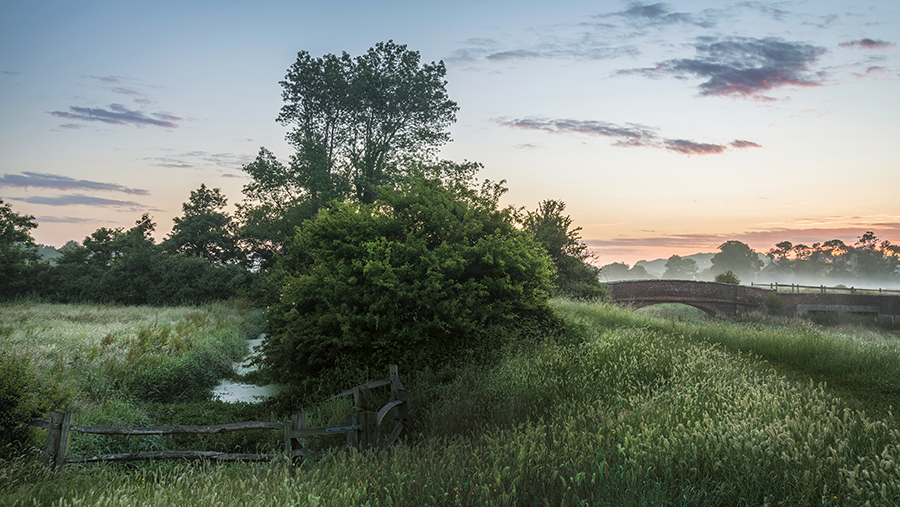Advertiser content
How Habitat Banks can help secure your financial future
As farmers and landowners continue on the seven-year Brexit transition journey, there is a raft of political, economic and legislative measures that will change.
From a financial perspective, a key shift is an end to the Basic Payment Scheme (BPS) which will be phased out by 2027.
It’s vital therefore that farmers and landowners explore other methods of long-term revenue and look at how they can create diversified and sustainable income streams to safeguard their future.
One way is through creating Habitat Banks in partnership with Environment Bank. Habitat Banks are a new, privately funded scheme that guarantees an income for 30 years.
The scheme was created as a result of Biodiversity Net Gain (BNG), a concept that was legally mandated under the 2021 Environment Act in November 2021.
Under the Act, all new developments and infrastructure projects in England are legally required to offset and deliver a minimum uplift of 10% in the amount of biodiversity as a result of the developer’s activity – called Biodiversity Net Gain.
Essentially leaving nature in a better state than before development began. The initiative is a game-changer in the way biodiversity is considered within the land and development sector.
BNG is the concept where the landscape and habitats impacted by a development are measured, and a score is applied to the biodiversity value of the land (in biodiversity units).
The total number of units is then increased by a minimum of 10% (many planning authorities are requiring a greater than 10% uplift) and this is the number that has to be delivered as part of the development planning permission.
The development masterplan is assessed and the number of units lost as a result of the development, calculated. For example, the land for development may have 136 biodiversity units; increase that by 10% and the developer has to deliver 150 biodiversity units.
Some of that can be accommodated within the development site boundary (as long as 30-years of funding is guaranteed by the developer). The remainder will be placed off-site, perhaps within proximity of the development.
We are now creating hundreds of Habitat Banks across England to accommodate the demand for frictionless delivery of BNG.
The Habitat Banks are established so as to generate ‘conservation credits’ which are purchased by the developer to make their development compliant with the mandated regime. And that’s where farmers and landowners have a role to play.
Why is habitat banking relevant to me?
Farmers and landowners play a key role in habitat banking. We partner with them to create new habitats at scale and pay them annually per hectare of land for managing it over a 30-year contract.
This contract is called a Conservation Bank Agreement. Our expert team of ecologists monitors how the Habitat Banks perform according to the objectives of a Biodiversity Management Plan that’s developed in partnership with land managers from the outset.
The plan is tailored to your needs and is relevant to your circumstances.
We also sign a Conservation Credit Purchase Agreement with the developer and issue them with Conservation Credit Certificates which they present to the planning authority to discharge their biodiversity net gain requirements.
We create Habitat Banks on many land types, usually 10ha+ in size where sufficient biodiversity uplift can be delivered with the appropriate conservation management interventions.
The best uplift occurs where we convert arable farmland into woodlands, wood meadows, species-rich grasslands, wetlands or rewilded sites.
We pay the cost of conversion upfront and then the focus is on management to achieve and maintain what is set out in the contracted plan.
We’ve been establishing trades in conservation credits derived from bespoke offset sites and habitat banks for many years. We find access to land is straightforward and we are building a national registry of sites.
We are also developing a future market in biodiversity from corporate non-developer clients to address nature-related financial disclosures.
Why should I choose habitat banking to secure my financial future?
Firstly, there’s no financial risk involved. Your habitat banking project is fully funded upfront. We are not dependent on the commercial environment or markets, so whatever may happen, there’ll be no risk or cost to you.
Your payments are guaranteed, it does not affect your land or tax status and you’ll receive your first year’s rent upfront then annual payments that increase with inflation for the 30 years.
We’re focused on tailoring our habitat banking management plans to what works best on your land and our ultimate aim is to make nature economically visible resulting in major changes in land use for the benefit of nature in the coming years.
We also work with the local authority to ensure the plan we devise for you is developed in a way that understands and takes into account local nature priorities so that the best biodiversity benefits can be achieved under your plan.
How does it work?
You simply need to register your land at www.environmentbank.com for an initial desk-based assessment. Our ecologists will visit your site to discuss the habitat options that are best for you and nature.
They will then work with our legal, accounting and land surveying teams to put together a comprehensive management plan, and work with you throughout the 30 years to ensure you’re happy with your habitat bank and that it’s delivering the best results.
We only take a lease interest in your land, which means you’ll retain full ownership throughout the 30-year term, as well as benefit from existing and emerging agricultural schemes and maintain income from other business activities as long as they are consistent with the biodiversity objectives.
Securing financial security and creating a new plan for our planet
Not only does our Habitat Bank scheme provide a realistic and long-term funding option for landowners, but it also enables you to support the restoration of biodiversity in the UK.
You’ll be playing a key role in creating a new plan for our planet – something we need to take urgent action on if we are ever going to deal with the dual threat of climate change and the nature emergency.
For more information, please call one of our experts on 01904 202990 or visit our website
Provided by
Environment Bank is leasing parcels of land to create biodiverse habitats that will play a key role in restoring ecosystems while also providing a secure, long-term income for farmers and landowners though Biodiversity Net Gain (BNG).


